
Torpedoes (Air Attack)
|
| Type |
Speed |
Range |
Run Time |
Drop Altitudes |
| American (Slow Type) |
39 mph | 4,570 yards | 4 mins |
960'
@ 200 mph 500' @ 225 mph <200' @ < 250 mph |
| German/Japanese (Fast Type) |
47 mph | 2,300 yards | 1 min 40 secs |
460'
@ 175 mph 300' @ 185 mph <200' @ < 200 mph |
To arm properly, slow torpedoes must enter the water at less than 250 mph. Fast torpedoes must enter the water at less than 200 mph.
Fleets steam at a standard speed of 34.5 mph (1000 yards/minute). Fleets can steam faster than standard for several minutes after turning.
Torpedo damage is double ordnance weight to account for damage under the water line.
One slow torpedo does 4,000 lbs. of damage. One fast torpedo does 3,520 lbs. of damage.
Sinking cruisers and destroyers requires 2,000 lbs. of damage, so one torpedo of any type will sink an undamaged cruiser or destroyer.
Sinking a CV requires 8,000 lbs., so two slow torpedoes will sink an undamaged CV. Three fast torpedoes will sink an undamaged CV.
Using fast torpedoes, you must wait at least 10 seconds after the fleet auto-ack begins firing at you before releasing. If you don't, your torp(s) will stop running before hitting the target.
Using slow torpedoes, you can drop before the auto-ack begins firing, but that gives the fleet more time to detect and avoid your torps. The recommended drop point is where the fleet ack begins firing.
The approach with the best chance of success is an attack run perpendicular to the fleet course, releasing when the bearing to the center of CV is 41° for slow torpedoes or 36° for fast torpedoes. Immediately after releasing, egress in the same direction as the fleet course at full power, descending to 50' or less.
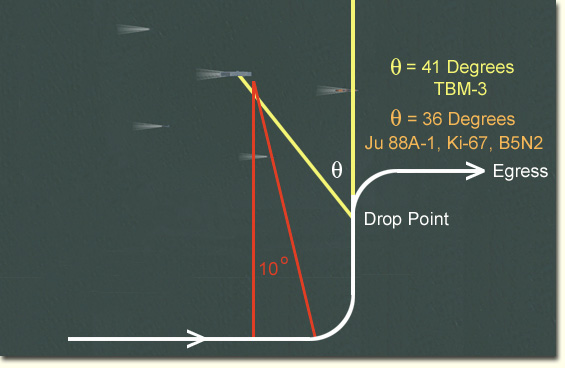
So how do we determine 36 or 41 degrees to our target from the cockpit? We'll set a visual reference for each plane as a bearing line. After we set it, we need to bring 4 parameters together at the drop point:
- Altitude under maximum for torpedo type
- Airspeed under maximum for torpedo type and altitude
- Heading perpendicular to fleet course
- Target on bearing line
Here are the bearing lines for each aircraft. Release when the bearing line is on the center of the target ship. You can place your mouse along the line just below the horizon or use the clipboard. If using the clipboard, reduce the size substantially and place the edge on the canopy alignment point. If your attack run is from the port side of the fleet, the right-hand alignment points for the TBM-3 and B5N2 are symmetrical.
Important: You must move back from the default cockpit view [Home] for these alignment points. Use the [Down Arrow] key below the End key to move back fully, then [F10] to save the view.
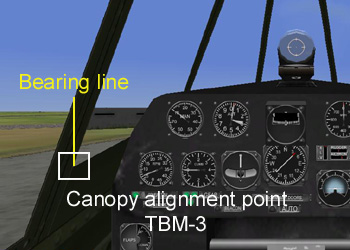 |
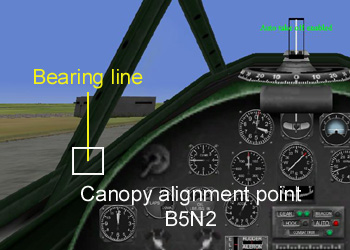 |
|
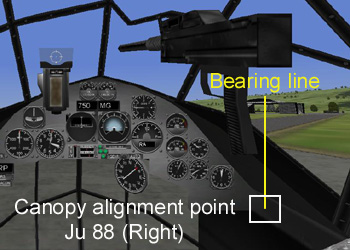 |
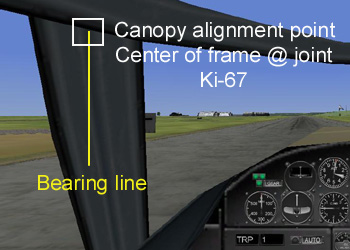 |
|
 |
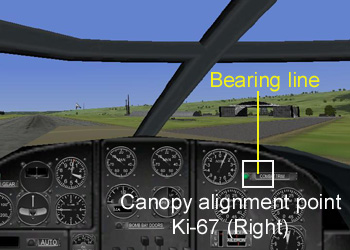 |
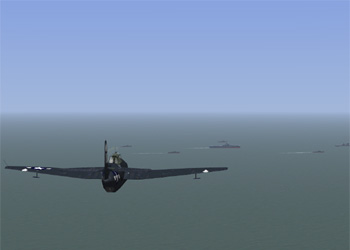 Approach Approach fleet @1500', 250 mph Scan horizon to spot fleet |
 Cockpit View Zoom to maximum [Z] []] When CV wake is in view, turn to fleet course |
|
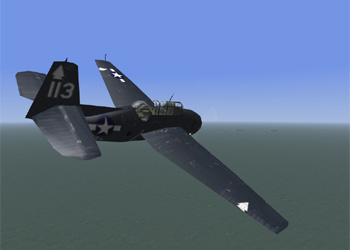 Parallel Course Zoom off [Z], bank 30°, flat turn Maintain altitude |
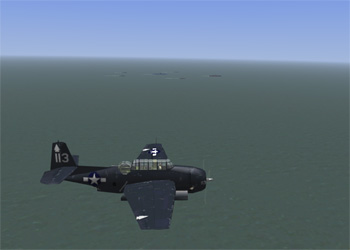 Abeam of CV Reduce throttle for 200 mph airspeed Bomb doors open [O] |
|
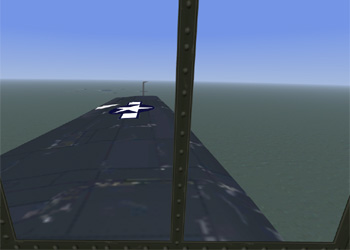 Align for Attack Run Turn Turn when pitot tube aligned with cruiser |
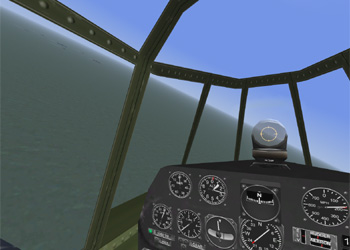 Attack Run Turn Throttle to idle, bank 30°, 1000 fpm descent |
|
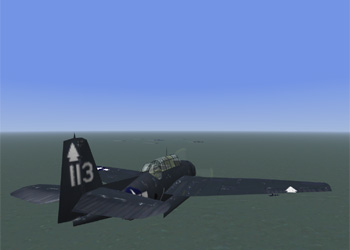 Attack Run Roll out on heading perpendicular to fleet course Continue 1,000 fpm descent |
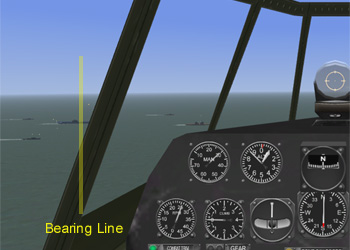 Drop Point <900', <200 mph, heading 90° to fleet Bearing line on target |
|
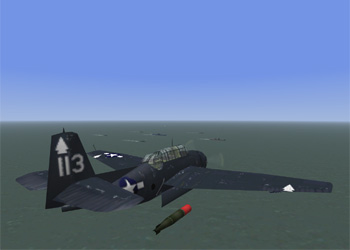 Drop Point Fleet ack just beginning to fire Release torpedo |
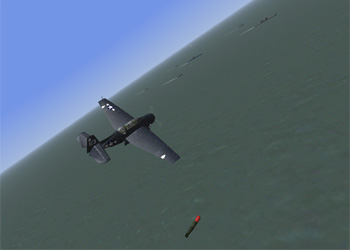 Begin Egress Hard turn to fleet course after drop Full throttle, descend to <100' |
|
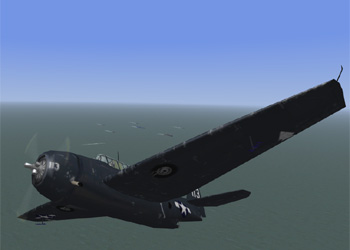 Egress Climb after outside fleet ack, doors closed [O] |
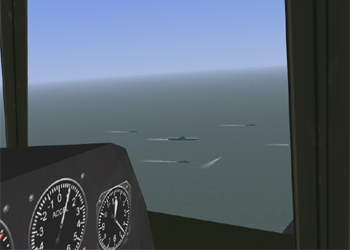 Torp Running Torpedo passes in front of destroyer |
|
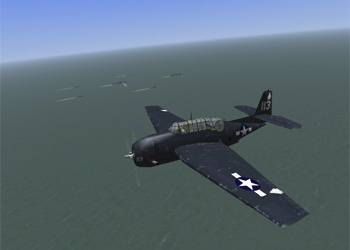 Torp Running One second from impact amidship |
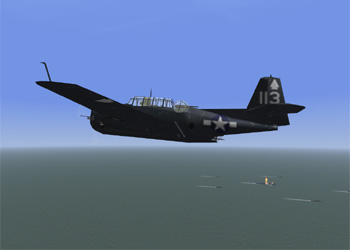 Impact Perfect strike with no aircraft damage |
Notes:
This TBM attack was used to present a method to practice and become familiar with the sight picture necessary to set up an attack run. Also, to illustrate that higher-altitude attacks can be successful. Torpedo attacks do not have to be below 200', but lower attacks do reduce the probability of being spotted and shot down by a ships gunner before releasing your torpedo.
You can approach the fleet from any direction. You'll have to estimate the fleet course and set up a perpendicular heading to that course at the right point in front of the fleet for your attack run.
One way to estimate 10° position after abeam of your target ship is to use maximum zoom [Z] []] in the side view. At maximum zoom, your field of vision is 30°, so you've traveled 10° when the ship center has moved 2/3rds the distance from the center to the trailing edge of your monitor.
by HammerOpen this page as a PDF formatted for printing Level bombing in Aces High II is not rocket science, but it does require some planning, patience, and an understanding of the systems used in order to be successful. The purpose of this write up is to shed some light on techniques that can make you a successful level bomber. These are certainly not the only or even the best methods to accomplish your level bombing mission, but they do work for me! Choose Your TargetThe first step in planning a bomber mission is to choose your target and which structures you wish to destroy at your target. You will use your situation awareness and your own personal goals to decide where you can successfully bomb and where you can help influence the battle. The most common targets are the airfield your country is trying to capture or the airfield that is attacking your airfield. Other popular targets include vehicle bases and an enemy’s HQ. With an effective strat system, factories and cities could also become popular targets. Once you've decided on your target, you must figure out how much ordnance it is going to take to destroy it. The chart below shows the various structures, what it takes to destroy them, how long they are down, and what effect their destruction has. Note the down times listed are the maximum down times if the base is not re-supplied. Drone supply convoys are constantly running and the enemy can re-supply a field from nearby bases so, with the exception of hangars and CVs, you will rarely see items down as long as indicated in the chart.
These values are subject to change Select Your Bomber and Bomb LoadChoosing which bomber to use for your mission is a matter of personal preference and what you hope to accomplish with your mission. If you want to destroy all of a certain type of target, you need to choose a plane that will allow you to carry enough bombs to do so. The number of bombs you will require to destroy a target will vary widely with experience and I won't try to give any guidelines other than to say practice and determine the minimum number of bombs you need to drop and the maximum number of targets you can destroy. Experiment with different bomb loads and remember that a formation allows you to accomplish missions with different bombs or salvo settings than you could with a single plane. If you are unsure what targets are going to be up at your target, 500 pound bombs are a flexible choice. Select your bomber and bomb load in the hangar. Below is a quick summary of the level bombers, ordered by bomb load: Lancaster III - Capable of carrying a whopping 14,000 pounds of bombs, the Lancaster is slow, climbs poorly, and has fairly weak defensive armament. Use for very high altitude bombing or in areas where your fighters own the sky. If you're going up high, plan on a long flight. It takes a Lanc over 35 minutes to reach 25k with 14k bombs and 25% fuel (see chart below). B-24J - The B-24J and the B-17G share the strongest defensive armament of all the bombers and have similar performance but, with the B-24 carrying 2,000 pounds of bombs more than the B-17 (for a total of 8,000 pounds), the B-24 instantly surpassed the B-17 in popularity when it was introduced with version 2.01. Unlike its use in the real world, the B-24J is more often used in Aces High for low altitude tactical strikes than high altitude bombing. Ju 88A-4 - It is probably a surprise to most people that the Ju 88 can carry a heavier bomb load than the B-17, but numbers don't lie. Capable of carrying 4 x 500kg bombs externally and another 20 x 50kg bombs internally, the Ju 88 can carry 3000kg (6,600 pounds) of ordnance, including 2 torpedoes. While it is faster than the B-17 below 20k, it has a lower rate of climb and much weaker defensive armament. Still, it has enough bombs to destroy a hangar or two with plenty left over to de-ack a field and then go to work on the fuel and ammo. If only it had a forward firing 20mm instead of the puny 7.7mm! B-17G - The B-17G, along with the B-24J, has the strongest defensive armament of
all the bombers and can carry a respectable 6,000 pounds of bombs. It is also
fairly fast (for a bomber), especially up high. Like the other level bombers,
you are as likely to see B-17s on the deck as up high. B-26B - The Marauder is a great bomber for rendering a field useless. Capable of carrying 4000 pounds of bombs, it can carry large bombs to destroy hangars or small bombs to destroy the ack, fuel and ammo. It has fixed, pilot controlled forward firing guns that allow lots of strafing. It is about 50 mph faster than a B-17 down low, making it a good choice for low altitude missions. Its main weakness is the lack of a belly gun, allowing undefended attacks from underneath. Keep it below 2,000 feet and that is not much of a problem (but the swarming enemy are!). Ar 234B - The only perk bomber currently in the game, the Arado Ar 234B is a jet powered bomber capable of carrying 1500kg (3,300 pounds) of bombs. Faster than most fighters at any altitude, the Arado is not immune to the fighter diving down from higher and for that reason should be flown at least at medium altitude where it will have a chance to dive away from an attacker. To fly at high altitude, you will probably have to sacrifice 1,000kg of bombs in order to take drop tanks needed to give you the range. TBM-3 - The only carrier based bomber capable of level bombing, the TBM can carry a torpedo or up to 2,000 pounds of bombs. It can also carry 6 wing mounted 5 inch High Velocity Aerial Rockets (HVAR) which gives it enough firepower to take out a hangar. However, since carrier launched fighters such as the F6F and F4U-1D can carry just as much ordinance, the TBM has a hard time making a place for itself in the arena and is usually flown as a novelty or for a torpedo attempt against an opposing fleet. Boston III - Introduced with Aces High version 1.10, the Boston III is an older cousin of the A-20G Havoc (also introduced in 1.10). The best performing level bomber, it is capable of carrying only 2,000 pounds of bombs and has very weak defensive armament. Because many fighters can carry more ordnance than the Boston III, this bomber will most likely find its use limited to scenarios. Ki-67 - Introduced in version 1.09, the Ki-67 "Hiryu" (Flying Dragon) is the first Japanese level bomber in the game. The Ki-67 is a fast bomber with a very good rate of climb but it carries a maximum of only 800kg (1,760 pounds) of bombs and lacks the pilot controlled guns of the B-26. It can carry a torpedo but torpedo runs are fairly rare. For these reasons, I suspect it will have difficulty finding a niche in the main arena. Still, its speed, climb rate, and the 20mm cannon in its dorsal turret make it a good choice for a quick strike bomber while its speed and climbing ability can allow it to survive high altitude missions. This bomber can also be flown in the attack mode. Formation or Single Sortie?There is little reason to take only a single bomber instead of a formation unless you plan on making a low level, nap-of-the-earth (NOE) run with lots of hard maneuvering. Even then, if you can get a formation to the target, you have 3 times the destructive power available. Decide Your Bombing Altitude and Calculate the Time/Distance to Get ThereYour next step in planning your bomber mission is to decide what altitude you want to be at over the target. You may also want to reach a certain altitude before entering enemy territory. Deciding these issues will help determine where to start your sortie and help you plan your route. Choosing an altitude to bomb from is a compromise of three issues: how long it will take to get there, the likelihood of being intercepted, and how accurate you are from altitude. How long it will take you to get to a certain altitude is plane dependent. Below is a chart showing how much time and distance it takes the various bombers to get to altitude with the indicated fuel load and the maximum bomb load using the default auto-speed. These measurements were taken in AH1. The AH2 performance may be slightly different but the measurements are still close enough for planning purposes. The likelihood of interception decreases with altitude. In the main arena, anything below 10k is low altitude. At these altitudes, the probability of interception by enemy fighters is almost 50% unless your side has total air superiority and the numbers to maintain it. Even then, you will probably need a gunner over the target so you can concentrate on dropping your bombs. If there is an even fight going on over your target, low altitude is probably not a good choice. From 10k up to about 20k is medium altitude. The risk of interception is still high, but it will more than likely be by one or two planes at a time instead of getting hoarded like you do at low altitude. The down side is it takes longer to get to these altitudes and will possibly be above a wind layer, making your bombsight calibration more difficult. If there is a hard-pressed even fight going on over the enemy base, a medium altitude run has a decent chance of making it. You will probably still need a gunner over the target, though. High altitude is 20k and up. The higher you are, the less likely you are to be intercepted. On the other hand, it can take some of the bombers a very long time to get to altitude. For example, a B-17G with 6k bombs and 25% fuel takes almost 20 minutes and 2 sectors (50 miles) to climb from sea level to 20k. Your accuracy at altitude will be a factor of practice. The more experienced you are, the more accurately you can bomb from higher altitudes.
|
| Nose | Tail | Dorsal/ Upper |
Ball/ Ventral |
Left Waist |
Right Waist |
|
| Ar 234B | - | - | - | - | - | - |
| B-17G | 5 | 4 | 3 | 2 | 6 | 7 |
| B-24J | 5 | 4 | 3 | 2 | 6 | 7 |
| B-26B | 4 | 3 | 2 | - | 5 | 6 |
| Boston III | - | - | 2 | - | - | - |
| Ju 88A-4 | - | - | 2&3 | 4 | - | - |
| Ki-67 | 2 | 6 | 3 | - | 4 | 5 |
| Lancaster | 2 | 4 | 3 | - | - | - |
| TBM-3 | - | - | 2 | 3 | - | - |
You have 2 options when firing your defensive guns. Firing your primary guns (F or joystick button 1) fires all guns which can hit the target. For example, if you were manning the tail guns of a B-17 and had an enemy approaching from 6 o'clock and slightly high, pressing your primary trigger would cause the not only the tail guns to fire at it, but also the upper turret. This usually brings a lot more firepower to bear on the target. Pressing your secondary trigger (B or joystick button 2) will fire only the guns you are manning. To return to the pilot's seat from one of the gunner positions, press 1.
Gunning for yourself enroute to the target is usually no problem but you may want to ask for a gunner as you approach the target. The reason for this is you can't gun and make a bomb run at the same time. If you make the bomb run, you are extremely vulnerable to enemy fighters. If you gun, you're not going to drop any bombs. Many fighter pilots wait for a buff to get near the target, where the pilot is probably in the bombardier's position, before making their attack. Often, a call on the country or squad channel is all it takes to find a gunner.
Like your views from the cockpit, you can adjust the views for each gunner's position and save them the way you want. See Aces High View System for more details.
Returning Home
After successfully dropping your bombs on target, it is time to return home. Generally, you will want to fly to the nearest friendly base that does not have a furball over it. If you are at high altitude, avoid the temptation to drop your altitude until you are sure you are safe from interception. It is better to fly to your base and then spiral down. Sure, it takes more time but the chances of a low fighter killing you on the way home are a lot less if you are way above it!
Bombers are extremely easy to land. They are some of the most stable planes out there and, with their huge wing areas, generally allow for very low speeds (well below 100 mph with flaps) before stalling. The hardest part about landing a bomber is getting slow enough that you can actually set down rather than float right over the field. In general, you will want to put you gear down at 130 or so and start lowering flaps. As your speed decreases, keep lowering flaps and make sure that you continue to descend. Push the nose down a bit if you have to and ride it in to a nice, smooth landing.
The Quicker Ride Home
If you're not interested in the long flight back to base, you might want to consider going down low and using up some machine gun ammo on the base or any enemy fighters that might be flying around. The B-26, with its fixed forward firing machine guns, is especially well suited for strafing airfields. The B-17G and B-24J with their ball turrets are also adept at hitting targets on the ground with machine gun fire. You can do a significant amount of damage to a field in this way, but you will often end your mission by being bounced by a swarm of angry enemy fighters.
Regardless of how your mission ends, if you managed to put your bombs on target, you can consider your mission accomplished!
Flight Instruction
Courtesy of Zeno's Warbird Videos
 Choose Your Route
Choose Your Route








 The first thing you should notice is the red text in the upper left corner of
your screen. Red text indicates the sight is not calibrated. The first line of
this information will tell you to press [U] (or whatever key you may have mapped
it to) to enter the calibration mode. (If it says "Press None to enter
calibration mode", it means you must map a key to this function.) The bombsight
calibration functions are found in the "Flight" keys list of your keyboard
mapping. For the rest of this write up, I will use the [U] key as the key which
takes you into the calibration mode and the [Y] key as the key which is used to
calibrate speed during calibration.
The first thing you should notice is the red text in the upper left corner of
your screen. Red text indicates the sight is not calibrated. The first line of
this information will tell you to press [U] (or whatever key you may have mapped
it to) to enter the calibration mode. (If it says "Press None to enter
calibration mode", it means you must map a key to this function.) The bombsight
calibration functions are found in the "Flight" keys list of your keyboard
mapping. For the rest of this write up, I will use the [U] key as the key which
takes you into the calibration mode and the [Y] key as the key which is used to
calibrate speed during calibration. When you press the [U] key to enter the calibration mode, the text in the upper
left of your bombsight screen expands and changes color to yellow. Under the
heading ***Calibration mode***, the text states "Auto speed measurement is
enabled. Hold down Y for at least two seconds. Holding it longer will increase
accuracy". That is not the whole story, though!
When you press the [U] key to enter the calibration mode, the text in the upper
left of your bombsight screen expands and changes color to yellow. Under the
heading ***Calibration mode***, the text states "Auto speed measurement is
enabled. Hold down Y for at least two seconds. Holding it longer will increase
accuracy". That is not the whole story, though!  Once
your bombsight is calibrated, continue to watch your E6B to ensure you
remain at the calibrated speed as indicated on your bombsight. Also look at the
two altitude notations on your bombsight: the "Drop Alt" and "Alt". "Drop Alt"
is the calibrated altitude and "Alt" is your current altitude. These two
altitudes should be the same. If they are not, you are either gaining or losing
altitude. While one or two feet shouldn't make a difference, they should be the
same for your calibration to be 50% accurate.
Once
your bombsight is calibrated, continue to watch your E6B to ensure you
remain at the calibrated speed as indicated on your bombsight. Also look at the
two altitude notations on your bombsight: the "Drop Alt" and "Alt". "Drop Alt"
is the calibrated altitude and "Alt" is your current altitude. These two
altitudes should be the same. If they are not, you are either gaining or losing
altitude. While one or two feet shouldn't make a difference, they should be the
same for your calibration to be 50% accurate. >
>





